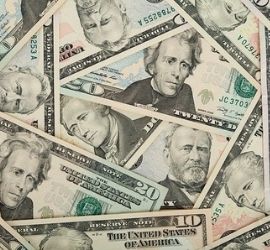What Is Net Cash Flow?
 Net cash flow refers to the difference between a company’s cash inflows vs outflows in a given period. Net cash flow also refers to the change in a company’s cash balance as reported on its cash flow statement. It is not the same as net income or free cash flow. It is strictly the change in the balance of cash and cash equivalents.
Net cash flow refers to the difference between a company’s cash inflows vs outflows in a given period. Net cash flow also refers to the change in a company’s cash balance as reported on its cash flow statement. It is not the same as net income or free cash flow. It is strictly the change in the balance of cash and cash equivalents.
Cash flow refers to either the gain or loss of funds over an accounting period. You can approximate a company’s net cash flow by looking at the period-over-period change in cash on the balance sheet. However, the statement of cash flows is a more specific place to look.
When a business has a surplus of cash after paying all its operating costs, it is said to have a positive cash flow. Positive cash flow is a symptom of financial health. However, some activities result in a positive cash flow, but may not be good for the business’s overall health. If the company is paying more for obligations and liabilities than what it earns through operations, it is said to have a negative cash flow. Net cash flow is the sum of total cash flow:
- Operating CFO – Cash flow from operations
- Investing CFI – Cash flow from investing
- Financing CFF – Cash flow from financing
Net Cash Flow Formula with Example
The Net Cash Flow Formula is relatively straightforward:
Net Cash Flow = Cash Flow from Operating Activities + Cash Flow from Financial Activities + Cash Flow from Investing Activities
However, the Net Cash Flow Formula can be simply stated as:
Net Cash Flow = Total Cash Inflows – Total Cash Outflows
Example
Company ABC has a net cash flow from operating activities of $50,000. There was also a net cash flow from financial activities of $40,000. However, Company ABC lost money from investments. This resulted in a net cash flow from investing activities of -$30,000.
Net CAsh Flow = $50,000 + 40,000 – 30,000 = $60,000
Company ABC’s net cash flow over the period is $60,000. Cash flow over the given period is positive. There is surplus cash to invest or reduce debts.
Why Net Cash Flow Matters
Cash flow is the fuel that helps companies survive and grow. With positive cash flow, they can develop new products, buy back stock, pay dividends, or reduce debt. It allows companies to conduct their day-to-day business. This is why some investors value net cash flow more than other financial measure, including earnings per share. Revenues and expenses are important, too, because they combine to determine cash flow.
Without long-term positive cash flow, a company will fail. However, it can offset the temporary short-term negative cash flow by borrowing. It is important to note that short-term negative cash flow is not always a bad thing. For example, a company may need to spend cash to build a second manufacturing plant. The investment will pay off in the end. Just as long as the plant eventually generates more cash than it cost to build.
You can look at net cash flow both for an isolated period of time, comparatively, and period over period. It’s important to do them all. The first shows you the likelihood of your business continuing in the short-term. The others give you a bigger picture of trends over time.
While you want to aim for positive cash flow, a period or two of negative cash flow isn’t necessarily a bad thing. You may have purchased significant investments, like a brick-and-mortar shop, which can put a dent in your short-term cash flow. But over time, your business should be able to recover and get back to a positive cash flow.
What is Net Income?
Net cash flow and net income are similar but there are key differences.
- Cash flow tells you how much operating cash moves in and out for a given period of time.
- Net income identifies what is left after including all expenses. Net income subtracts both operating expenses and non-operating expenses. This includes taxes, depreciation, amortization, and others.
A net profit is when a company earns money after accounting for all those expenses, so the number is positive. When the number is negative, this is recorded as a net loss and indicates the company has lost money for that period. Net income gives a bigger, more accurate look into profitability. However, net cash flow indicates a business’s ability to earn a profit from typical business operations.
What Is Net Cash?
- Net cash is a figure that is reported on a company’s financial statements. It is calculated by subtracting a company’s total liabilities from its total cash. The net cash figure is commonly used when evaluating a company’s cash flows. Net cash may also refer to the amount of cash remaining after a transaction has been completed and all associated charges and deductions have been subtracted.
- Net cash flow refers to either the gain or loss of funds over a period (after all debts have been paid). When a business has a surplus of cash after paying all its operating costs, it is said to have a positive cash flow. If the company is paying more for obligations and liabilities than what it earns through operations, it is said to have a negative cash flow.
- Negative cash flow does not mean a company is unable to pay all of its obligations; it just means that the amount of cash received for that period was insufficient to cover its obligations for that same time period. If other savings vehicles are liquidated to meet the obligation—or additional debt is accrued that does not involve the receipt of a lump sum deposit—a company can meet all of its obligations while maintaining a negative cash flow.
Analyzing what activities contribute to positive or negative cash flow is essential when using cash as a barometer for determining the financial health of a company. Positive net cash from events such as increased profits from sales, or reduced obligations, can be indicative of a well-functioning, healthy firm. However, certain activities may result in a positive cash flow that may not reflect positively on a company’s financial health, such as money received as a result of incurring a new debt or activities associated with a loan deposit.
Final Words
Positive cash flow is a symptom of financial health. However, some activities result in a positive cash flow, but may not be good for the business’s overall health. For example, a business may have received an injection of cash after taking on new debt. This may result in a positive cash flow, but it’s not necessarily ideal for financial health moving forward. There is now more interest expense to deal with.
On the other hand, negative cash flow isn’t always a bad thing. A negative cash flow may result from investments. In reality, the investment will ultimately boost revenues in the future. For example, investing in new machinery or real estate may leave a company temporarily in the red. However, they expect to make the money – and with a handsome profit as well.
It’s also important not to focus exclusively on cash flow when calculating your business’s financial viability. There are other financial measurements that you should pay attention to. These include changes in overhead and fluctuations in the level of debt that a business has taken on. This is also why it’s important to consider other metrics in addition to your net cash flow. Keep in mind things like free cash flow, operating cash flow, discounted cash flow, and others.
Up Next: What Is a Leveraged Buyout?
 A leveraged buyout (LBO) is the acquisition of a company using a significant amount of borrowed money to fund the purchase. Assets are used as collateral for the additional debt. This includes assets of the company being acquired as well as assets of the acquiring company. In a leveraged buyout (LBO), there is usually a ratio of 90% debt to 10% equity. The purpose of a leveraged buyout is to allow a company to make a large acquisition without having to commit as much capital.
A leveraged buyout (LBO) is the acquisition of a company using a significant amount of borrowed money to fund the purchase. Assets are used as collateral for the additional debt. This includes assets of the company being acquired as well as assets of the acquiring company. In a leveraged buyout (LBO), there is usually a ratio of 90% debt to 10% equity. The purpose of a leveraged buyout is to allow a company to make a large acquisition without having to commit as much capital.
In the world of corporate finance, a leveraged buyout (LBO) is a transaction where a company is acquired using debt as the primary source of funding. LBO transactions typically occur when a private equity (PE) firm borrows as much as it can using a variety of lenders. Up to 70 – 90 percent of the purchase price is funded with borrowed money. The remaining balance is funded with their own equity.



